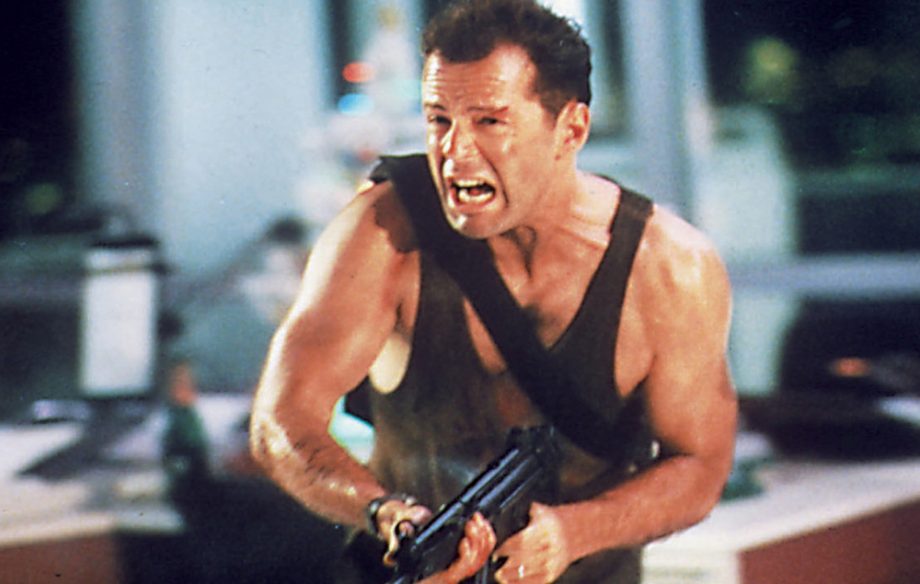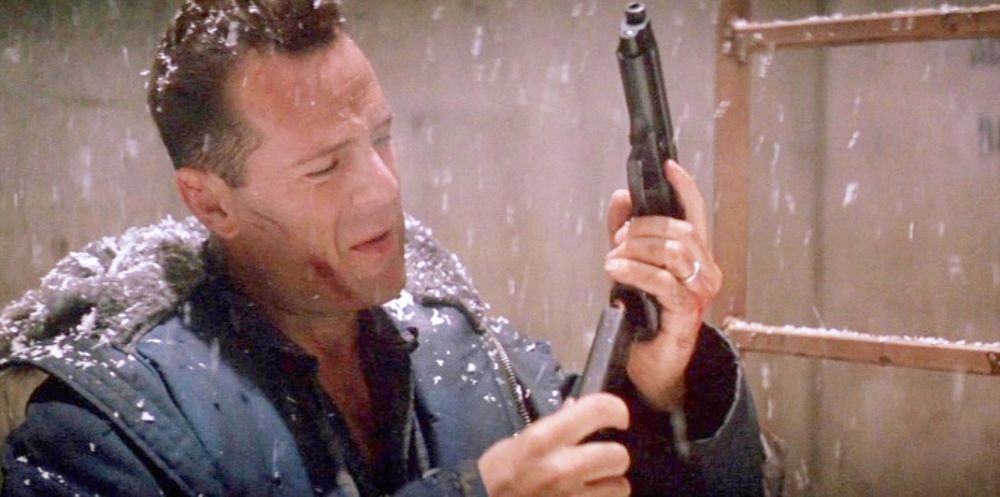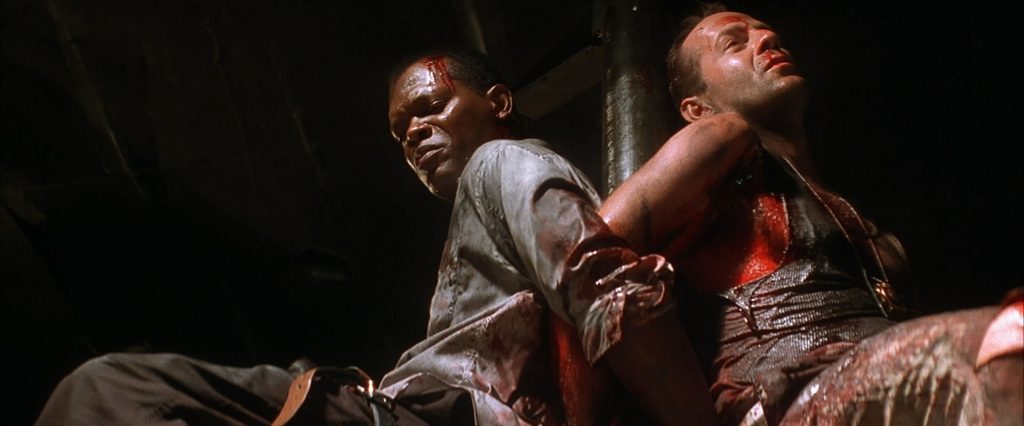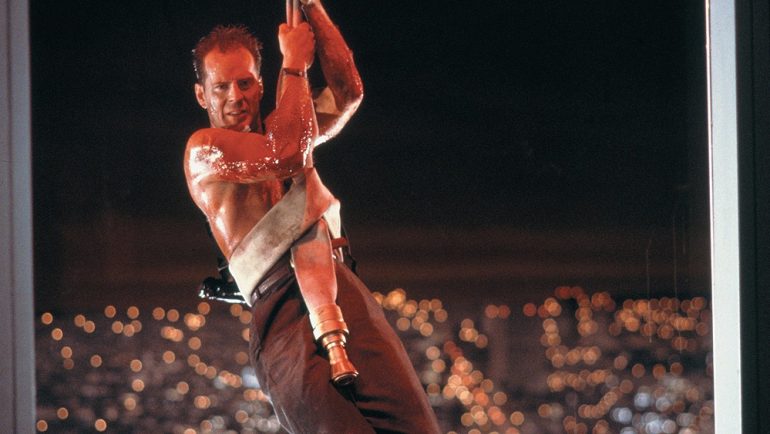John McClane. When the name is spoken, what images come to mind? Broken glass, burning airplanes, speeding taxis? McClane is the ultimate everyman, the guy who doesn’t have superpowers or mechanical upgrades, just a determined New York City cop with brains and a gun. Starting in the ’80s, McClane’s legacy in the hallowed halls of action is undeniable. However, of the Die Hards, which one is the best? I’ve decided to not include Live Free or Die Hard and A Good Day to Die Hard; the neutered PG version of the former drops it from contention, while the latter, the less said about it, the better. Let’s take a look into the movies that turned John McClane from an NYC cop with a failing marriage into the epitome of the one-man army.
Die Hard (1988)

Story: The original John McClane story had pretty humble beginnings. It looks like another rom-com where a cop flies out to a place he’s unfamiliar with and seeks out his estranged spouse. As the typical story would go, they would find some commonality despite their differences, they would grow despite the associated pains in doing so, and by the end of the movie, would re-discover their love for each other. Except, that’s now how this story goes. No, Hans Gruber and his gang put a crimp it the plans, changing John McClane from flagging family man to man of action. The great thing about the first movie’s story is how it unfolds – it both happens all at once and gradually. Hans and his group blitzkrieg the Nakatomi Building and before you know it, almost everyone is a hostage. From there, we gradually see McClane react, making it up as he goes along, attacking whenever possible, and figuring out how to get to the end. The audience goes along with him, and are constantly surprised by how he improvises and continues to be a thorn in the side of a much better financed and prepared adversary. The story, as much as Bruce Willis’ pitch-perfect acting in the role, is what makes John McClane more than an action hero protagonist and leads to his legendary status.
Villain: For a perfect foil to John McClane, you can’t get better than Hans Gruber. He is the exact opposite of McClane, cultured, suave and yet sinister, he is above McClane’s potty-mouthed detective, and he comes with an ironclad game plan on achieving his goals. While McClane is the fly in his ointment, Hans is not above sacrificing his men to take out his nemesis. He rules like a king over his kingdom, and while McClane is relentless in his attacks, Gruber is intellectually more than a match for a New York beat cop. It is only for McClane’s sheer determination that he inevitably bests his rival, but if Gruber was not forced to end up playing McClane’s game and come out from behind his men to do battle with his rival, the end would have been much different.
Action: Oh yes, there’s plenty of that. What do you want to talk about? The gunfights, the hand-to-hand battle with Gruber’s right-hand man Karl, the daredevil jump off the exploding rooftop, which also takes out an FBI helicopter, the attack on the armoured police car or the final showdown between cop and criminal? Die Hard is a gritty, claustrophobic action film and while there are certainly some (pardon the pun) explosive flourishes, the film sticks to realistic battles, where it’s either shootouts or McClane battling someone else, using brawn, blunt force, sheer frustration, and anger to overcome his better-equipped foes. While the average viewer can admire Bruce Lee and Jackie Chan’s athletic feats of martial arts, here was a hero who used his fists, proficiency with a gun, and insults to get the job done. This everyman mode of action made him instantly relatable and thus, made him stand out above the rest.
Die Hard 2: Die Harder (1990)

Story: Whereas McClane was stuck in a building in the first film, this movie broadened his playground, giving him the run of a major metropolitan airport. Also, unlike the first film, the intentions of the villains are a little clearer – they want to save a known drug czar from a foreign country. This makes the movie a little more straight-forward – there’s no trick on the villains’ motives at the end of the movie. The biggest change though is the addition of a noted time restraint – while in the first film, the FBI is threatening to move in, it’s clear from the start of the movie that the first Die Hard is McClane’s show. In this one though, he can’t control the fact that this wife’s plane is running out of fuel, nor can he control when Esperanza is going to land. This addition gives a heightened suspense that the first film didn’t really have. Otherwise, it is extremely similar to the first one, where McClane single-handedly has to battle a group of trained and loaded bad guys who would normally be able to overpower any opposition – but this is John McClane we’re talking about here.
Villain: William Sadler’s Colonel Stuart is cold, merciless, and brutal. Lacking the finesse and polish of a Hans Gruber, Stuart is a career military man who is used to things running like clockwork and powering ahead through opposition to a goal. This puts him much more on par with McClane. However, there is still a certain arrogance to Stuart’s character, a sense that he feels McClane isn’t much of a threat, that makes him vulnerable to McClane’s improvised attacks. The secondary villain of Major Grant, played by John Amos, is a bit less of a character and more of a twist, a supposed ally who is working for the other side. The revelation of his true alliance throws our hero off-guard, but as always, McClane figures out a way to overcome his adversaries.
Action: Whether it’s battling skilled mercenaries, attacking a church full of men or battling on the wing of a 747, Die Hard 2 does not disappoint in the action department. The broader and different settings allow for more variety, allowing McClane more freedom to do more outrageous stunts, like the fight between him and Stuart and Grant outside the plane. While it lacks the restrictiveness in setting that made McClane’s character to act in a more clever action from the first film, it allows bigger action pieces, including ejecting out of an exploding plane, a stunt that would not have been possible in the first film.
Die Hard with a Vengeance (1995)

Story: If you think that fighting in and around an airport broadened McClane’s horizons, imagine if he had the entire city of New York as his playground. The third Die Hard movie pulls out all the stops and makes McClane do battle across the entire city, changing the McClane from ordinary cop forced to do extraordinary feats to traditional, impenetrable action hero. This movie also changed things up by giving him a partner, Samuel L. Jackson’s Zeus. While you could argue that McClane doesn’t really need a partner (which would be backed up by the first two films), this movie continued to evolve the McClane story, turning the movie from a one-man army tale to a buddy story. It was this constant evolution of the Die Hard mythos that made people interested in coming back for more, though the later two films seemed to remain somewhat stagnant in the buddy action genre. However, this film continued to give you bang for your buck, and with Willis and Jackson trading quips amongst crises, the movie remained entertaining and interesting, a rare feat for the third film in a trilogy.
Villain: Jeremy Irons, who plays the deceased Hans Gruber’s villain Simon, is the most personal of McClane’s nemeses. Unlike the other villains in the Die Hard movies, Simon has a reasonable and logical reason to personally hate John McClane, as he was responsible for the loss of Simon’s brother. This makes the twist about Simon’s motives more effective, I would argue, than the first film as it was obvious from the start that Hans was interested in whatever was in the vault and was using the foreign terrorist narrative as a ploy. In this one, Simon’s turn is more surprising and interesting. That aside, Simon Gruber is a great villain, not caring about drowning innocent people to cover his escape, nor about forcing McClane to degrade himself for his own amusement.
Action: With the entire city at his disposal, this film broadened the variety of action scenes more than any Die Hard movie to date. There were battles in elevators, in the subway station, a car chase through Central Park, a harrowing escape in a reservoir, another battle on a ship on the docks, and they even jumped the 51st parallel and ended the movie in Canada. While this film really diversified the action scenes, I do believe that the final confrontation between McClane and Simon in Montreal was a bit of a letdown. Unlike the first two movies, this ending felt tacked on, which was later confirmed in the special features of the DVD, which revealed a much darker (though one could say less anti-climatic) showdown between McClane and Simon. This is the only criticism I have of the action, as otherwise, I applaud the filmmakers for continuing to think bigger and better for the Die Hard franchise.
The Verdict
While it’s hard to pick one movie from these three, as they do feel like a cohesive series of stories that continue to evolve the John McClane storyline, I would have to say that the first film is probably the best of the three. I think that McClane’s actions and resourcefulness are just more surprising and the spacial limitations on him more interesting than the other two films. That being said, the first three Die Hard films are definitely a hallmark in the action genre and a great starting point for any young fan looking to get into the action genre.






